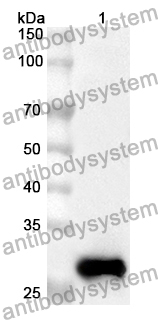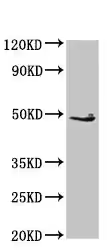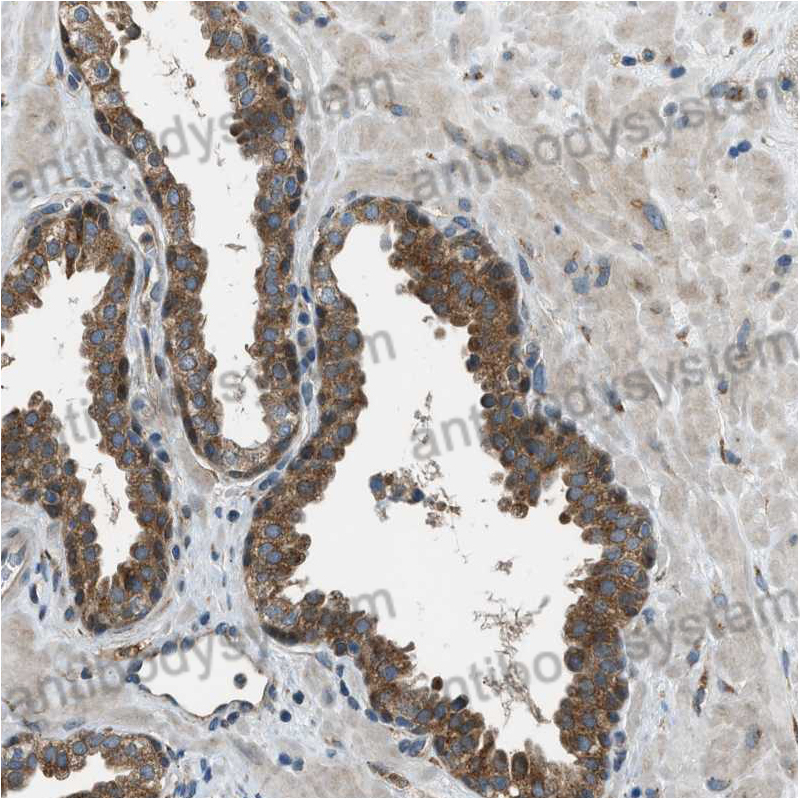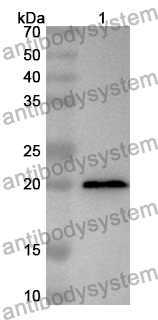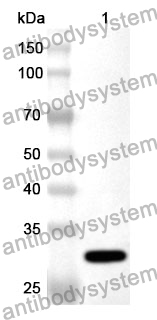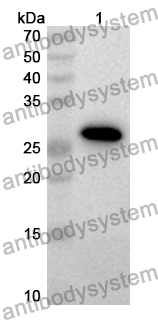Catalog No.
PHJ81701
Species reactivity
Human, Mouse, Rat
Host species
Rabbit
Isotype
IgG
Clonality
Polyclonal
Immunogen
E. coli - derived recombinant Human EDAR (Lys212-Ser448).
Tested applications
ELISA: 1:4000-1:8000, IHC: 1:50-1:100, WB: 1:1000-1:4000
Target
DL, Ectodermal dysplasia receptor, EDA-A1 receptor, EDAR, Tumor necrosis factor receptor superfamily member EDAR, Ectodysplasin-A receptor, Anhidrotic ectodysplasin receptor 1, Downless homolog
Purification
Purified by antigen affinity column.
Accession
Q9UNE0
Applications
ELISA, IHC, WB
Form
Liquid
Storage buffer
0.01M PBS, pH 7.4, 50% Glycerol, 0.05% Proclin 300.
Stability and Storage
Use a manual defrost freezer and avoid repeated freeze thaw cycles. Store at 2 to 8°C for frequent use. Store at -20 to -80°C for twelve months from the date of receipt.
The EDA-deficient mouse has Zymbal's gland hypoplasia and acute otitis externa., PMID:35107126
Sequential Ensemble-Decision Aliquot Ranking Isolation and Fluorescence In Situ Hybridization Identification of Rare Cells from Blood by Using Concentrated Peripheral Blood Mononuclear Cells., PMID:33528996
Methods for the Administration of EDAR Pathway Modulators in Mice., PMID:33185875
Recurrent episodes of syncope requiring pacemaker implantation as an initial presentation of neuromyelitis optica spectrum disorder., PMID:32745996
Role of ectodysplasin signalling in middle ear and nasal pathology in rat and mouse models of hypohidrotic ectodermal dysplasia., PMID:31028034
Regulatory B and T lymphocytes in multiple sclerosis: friends or foes?, PMID:30415321
Anti-EDAR Agonist Antibody Therapy Resolves Palate Defects in Pax9-/- Mice., PMID:28813171
CD68 on rat macrophages binds tightly to S100A8 and S100A9 and helps to regulate the cells' immune functions., PMID:27312849
Carcinogenesis of nasopharyngeal carcinoma: an alternate hypothetical mechanism., PMID:26738743
Improved detection by ensemble-decision aliquot ranking of circulating tumor cells with low numbers of a targeted surface antigen., PMID:26302174
Pharmacological activation of the EDA/EDAR signaling pathway restores salivary gland function following radiation-induced damage., PMID:25409170
Pharmacological stimulation of Edar signaling in the adult enhances sebaceous gland size and function., PMID:25207818
Ectodysplasin A (EDA) - EDA receptor signalling and its pharmacological modulation., PMID:24508088
Generation and characterization of function-blocking anti-ectodysplasin A (EDA) monoclonal antibodies that induce ectodermal dysplasia., PMID:24391090
Future application of hair follicle stem cells: capable in differentiation into sweat gland cells., PMID:24034106
Sensitive and high-throughput isolation of rare cells from peripheral blood with ensemble-decision aliquot ranking., PMID:22359315
Harnessing tumor necrosis factor receptors to enhance antitumor activities of drugs., PMID:21740002
Molecular and therapeutic characterization of anti-ectodysplasin A receptor (EDAR) agonist monoclonal antibodies., PMID:21730053
Biological activity of ectodysplasin A is conditioned by its collagen and heparan sulfate proteoglycan-binding domains., PMID:19657145
Impaired hair placode formation with reduced expression of hair follicle-related genes in mice lacking Lgr4., PMID:18651655
High level production and one-step purification of biologically active ectodysplasin A1 and A2 immunoadhesins using the baculovirus/insect cell expression system., PMID:15294294
Enhancement of therapeutic potential of TRAIL by cancer chemotherapy and irradiation: mechanisms and clinical implications., PMID:15158769
Mucosal addressin cell adhesion molecule 1 plays an unexpected role in the development of mouse guard hair., PMID:12230506
Signaling and subcellular localization of the TNF receptor Edar., PMID:11570810

